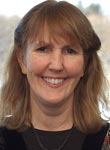Citizen science is central at Lab of Ornithology
By Lauren Gold

Members of the public have been contributing to scientific research for centuries, but the Internet and social media have dramatically boosted the power of citizen science -- creating new opportunities in science and education across the disciplines, said Cornell's Janis Dickinson, Feb. 20 at the annual meeting of the American Association for the Advancement of Science in Washington, D.C.
At Cornell, researchers have worked closely with citizen scientists since the 1960s, said Dickinson, an associate professor of natural resources and director of citizen science at the Cornell Lab of Ornithology. Co-organized with Bart Selman, Cornell professor of computer science, the symposium "Crossing Boundaries with Citizen Science" focused on the growing role of citizen science in the digital age. Selman moderated the session.
"The Internet has transformed our capacity to harness the small acts of many to tackle large problems of collecting and processing data," Dickinson said. "Not only are biologists crossing boundaries and working with computer scientists, the line between professional and public participation in science is beginning to blur."
More than 60 scientific papers have used Cornell Lab of Ornithology citizen-science data since 1997, Dickinson said; and the lab has a wide variety of ongoing monitoring projects that rely on public participation to assess bird populations and distribution around the world.
New work at the Cornell Lab of Ornithology is engaging participants in conservation efforts through projects like YardMap, a National Science Foundation-funded, map-based social networking tool that supports sustainable practices in backyards and parks. And millions of observations per year are logged through eBird, a joint project of the lab and the National Audubon Society that uses graphing, mapping and analysis tools to study patterns of bird distribution and the environmental and human factors that influence them.
The growing power of the public has led to new approaches in science education and created a need for innovation in informatics, cyberinfrastructure, Web application development, human computation and data mining, Dickinson said.
"But some of the new tools we are building, particularly the YardMap, hold the potential for a novel kind of learning via the Web," she said. "We expect participants to collaborate and become innovators, sharing and inventing new sustainable practices that propagate through the social network. It is even possible that we will see collective intelligence emerging as people begin to collaborate and even compete within the network."
Taken together, she added, the innovations are transforming the study of birds, ecology and more, giving Lab of Ornithology researchers new ways to harness the ingenuity, skill, altruism and passions of millions of engaged and enthusiastic individuals.
Get Cornell news delivered right to your inbox.
Subscribe